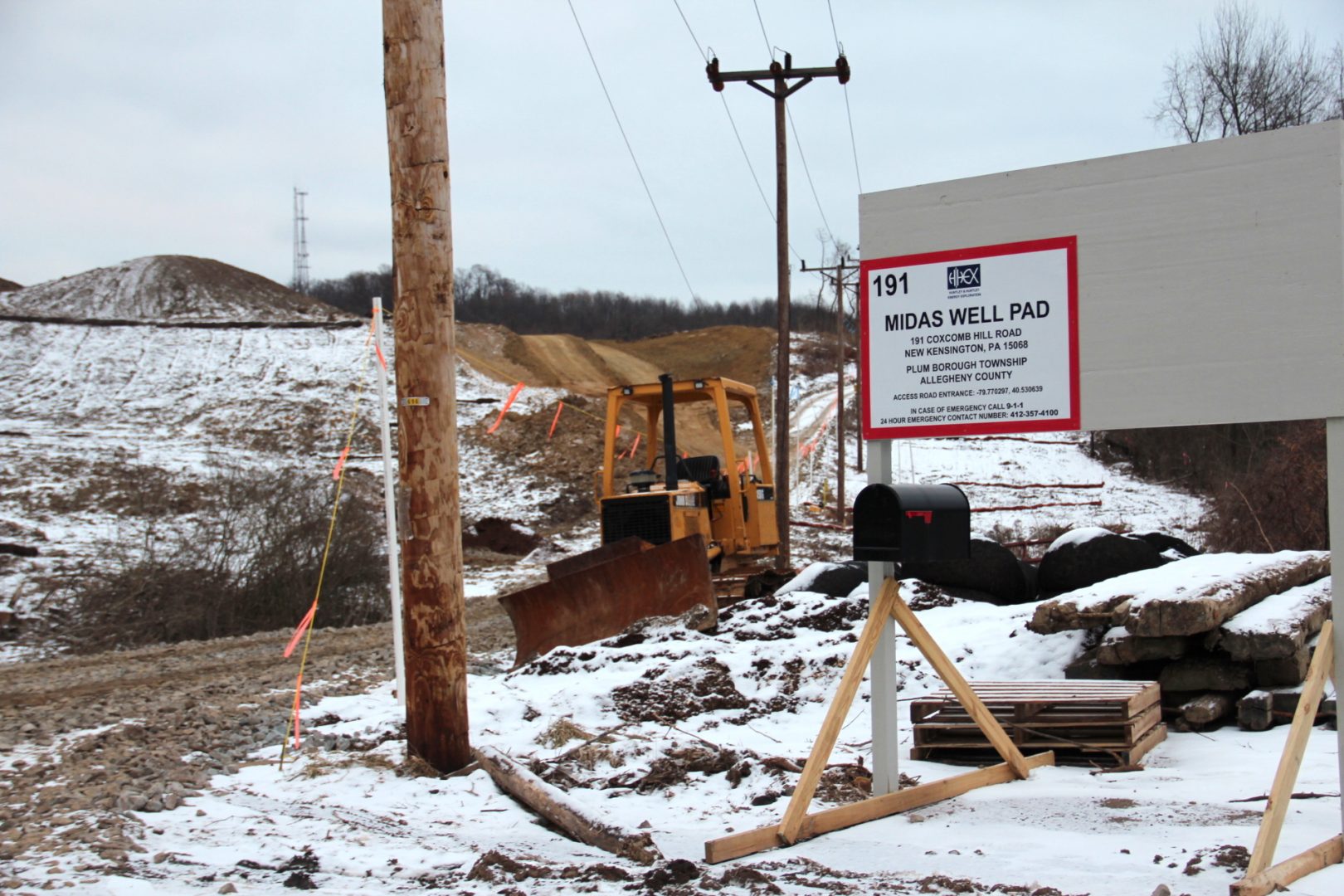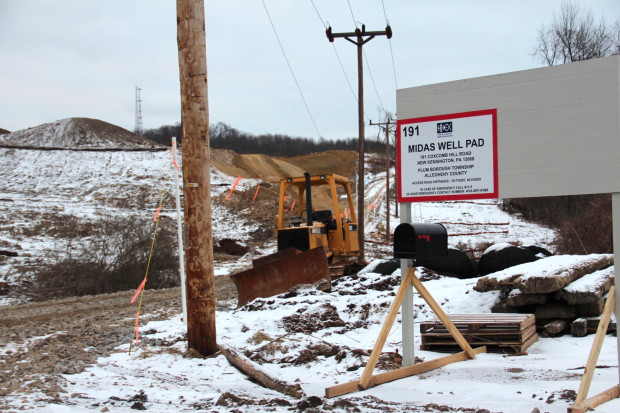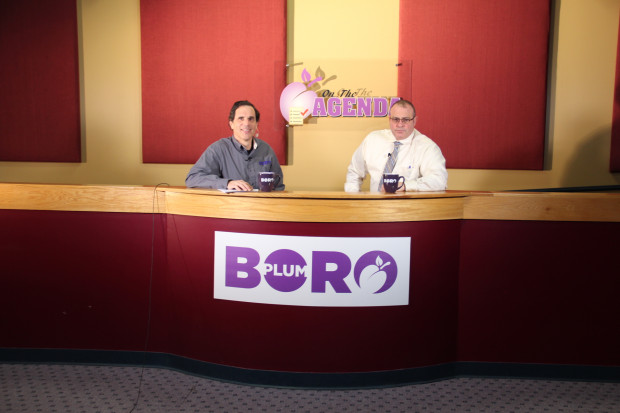
Huntley & Huntley Energy Exploration's Midas Well pad, the first Marcellus shale gas well in the Pittsburgh suburb of Plum.
Reid R. Frazier


Huntley & Huntley Energy Exploration's Midas Well pad, the first Marcellus shale gas well in the Pittsburgh suburb of Plum.
Reid R. Frazier

Reid R. Frazier
Huntley & Huntley Energy Exploration's Midas Well pad, the first Marcellus shale gas well in the Pittsburgh suburb of Plum.

Huntley & Huntley’s Midas Well pad, the first Marcellus shale gas well in the Pittsburgh suburb of Plum. Photo: Reid R. Frazier” credit=”
Michael Thomas didn’t think the Marcellus shale industry, with its multi-acre well pads and large drilling operations, would come to the Pittsburgh suburb of Plum.
But then one day last summer, it did.
“I was on vacation and I got an e-mail from a council member that said, ‘Are you going to the meeting tonight?’” said Thomas, the borough manager. “And my response was, ‘What meeting?’”
It was a public hearing for an underground injection well for fracking waste, held by the EPA. Around 200 residents came out to oppose the project. Pretty soon the borough got word that another company wanted to build shale gas wells in Plum.
This came as a surprise to Thomas, the borough’s manager for 13 years. There were small, conventional gas wells in Plum. But Thomas thought the drilling industry would stay in more rural parts of the state.
“We were not anticipating a lot of requests or a lot of permit requests for wellheads in Plum because — all things being equal — you can get a lot more property up in Elk County, a lot cheaper, than you can in Allegheny.”
Gas drilling in Pennsylvania has largely bypassed Pittsburgh. Map: FracTracker Alliance
But in the last couple of years, interest in gas drilling in Pittsburgh’s suburbs has slowly but surely increased. Wells have been permitted or are being planned for as close to four miles from the city line. And according to research from the oil and gas watchdog Fractracker Alliance, about 18 percent of Allegheny County is leased to gas drillers.
That has rekindled a debate about the risks and rewards of drilling in suburban Pittsburgh, as suburbanites and elected officials now have to decide what to do about fracking in their backyards.
Risk vs. reward
Fracking has brought jobs to Pennsylvania and riches for some landowners, but also controversy. Opponents say the process burdens local communities with truck traffic, emissions from gas wells, and potential harm to groundwater.
But that debate has largely skipped over Pittsburgh and its biggest suburbs — until now. It’s not hard to see why.
“If you look at a map of oil and gas operations in Pennsylvania, you’ll immediately take note that Allegheny County looks like an island in a sea of gas wells on their maps,” said Doug Shields, a former Pittsburgh city council member, and now an outreach coordinator for the environmental group Food & Water Watch.
“It’s only a matter of time before (fracking companies) come into these high-density populations.”
S&P Global Platts energy analyst Taylor Cavey said in an email that the reason for the interest in Allegheny County could be from the buildout of pipelines in the area and the sheer volume of gas beneath the ground there, which rivals that of Washington County. In Washington County, the production from Marcellus gas wells there is around 12 million cubic feet a day. In Allegheny County, the initial production rate is now between 4 and 12.9 million cubic feet a day.
Still, drilling companies have so far stuck to the surrounding, more rural counties. Allegheny County has just over 134 Marcellus gas wells, while Washington County, to the south, has 1,710, according to Pennsylvania Department of Environmental Protection data.
Allegheny County Drilling, Leasing, and Zoning Map: FracTracker Alliance
Drilling close to Pittsburgh is complicated by the fact that Allegheny County has 130 municipalities, some as small as 50 acres. Each can regulate fracking through zoning. So deciding where companies can drill is now becoming a big, open question in Pittsburgh’s suburbs.
Through his job with Food and Water Watch, Shields offers to help communities update local laws to include gas drilling restrictions. Only about a third have zoning ordinances that have up-to-date oil and gas designations. But he said that’s beginning to change.
“These communities kind of woke up quickly and began to understand they need to protect themselves,” Shields said.
Oakmont, next to Plum, has enacted strict limits on where companies can drill gas wells. Monroeville also adopted a restrictive zoning policy; but the municipality is now considering an ordinance that would allow drilling in more areas.
Striking a balance
A few months ago, Plum decided to allow drilling in about one-third of the municipality. Thomas, the Plum manager, said that was a compromise. Some residents who owned gas rights wanted to expand the map to allow drilling in more densely populated areas. Others wanted to restrict it to just a handful of industrial zones.
“My rule is always to try to strike the balance,” said Thomas, who convened a panel of local officials, planning commission members, and sought out expert advice on how to regulate fracking.
If you don’t let people make money, he said, you won’t have a healthy economy. But “if you have everything running rampant,” people will move away.
He said public opinion in the borough was mixed, but that most he talked to were friendly to the idea of drilling.
“I’d say six out of every 10 people that I talked to (said), ‘Let’s drill,’” he said. “But four of every 10 (said), ‘We’ve got to think about this, we’ve got to stop this.’”
On top of that, he worried that the company drilling the well, Huntley and Huntley, would sue if the borough made its ordinance too restrictive, especially since Plum had allowed smaller wells to be drilled in most parts of the municipality.

Plum borough manager Michael Thomas, right, being interviewed by Vince Lagrotteria for the community’s local access television show. Photo: Reid R. Frazier” credit=”
Huntley and Huntley did not agree to an interview. But in an email, a company spokesman said that environmental problems predicted by environmentalists at the company’s other sites — like Allegheny County’s Deer Lakes Park — never materialized, and that the company was concentrating its Marcellus drilling on the more sparsely populated parts of the municipality.
“Oil and gas development in these less developed areas will have the benefit of allowing these landowners, who are oftentimes under economic pressure to maintain their open spaces, the ability to keep them as-is, rather than having to sell their land for more intensive development,” said company spokesman Dave Mashek, in an email.
The company’s first Marcellus gas well in Plum is currently taking shape.
Backhoes move dirt around the well-pad, which resembles a typical construction site. But in a few months, a drilling rig will be moved on site, to drill down more than a mile underground into the Marcellus shale.
Dave Vento, a former Plum councilman, doesn’t want to see fracking of this scale come to Plum. He’s worried about truck traffic, potential damage to water wells, and whether the development of shale gas wells will drive down property values. He says he understands some of his neighbors would benefit from lucrative royalty payments, but doesn’t think it’s worth it.
“Absolutely, it’s good for them — but at what cost to the rest of the community?” said Vento, who is a foreman for the Pennsylvania Turnpike. “You live in a community, you don’t live by yourself. This isn’t the Wild Wild West. We live in a community. We’re surrounded by humans — you know? It’s just — what you consider your right, (versus) what you don’t consider your right.”
As drilling moves into the suburbs here, it’s a question more and more people will be asking.
UPDATE: This story was updated to clarify the ownership of the Midas Well.
StateImpact Pennsylvania is a collaboration among WITF, WHYY, and the Allegheny Front. Reporters Reid Frazier, Rachel McDevitt and Susan Phillips cover the commonwealth’s energy economy. Read their reports on this site, and hear them on public radio stations across Pennsylvania.
(listed by story count)
StateImpact Pennsylvania is a collaboration among WITF, WHYY, and the Allegheny Front. Reporters Reid Frazier, Rachel McDevitt and Susan Phillips cover the commonwealth’s energy economy. Read their reports on this site, and hear them on public radio stations across Pennsylvania.
Climate Solutions, a collaboration of news organizations, educational institutions and a theater company, uses engagement, education and storytelling to help central Pennsylvanians toward climate change literacy, resilience and adaptation. Our work will amplify how people are finding solutions to the challenges presented by a warming world.